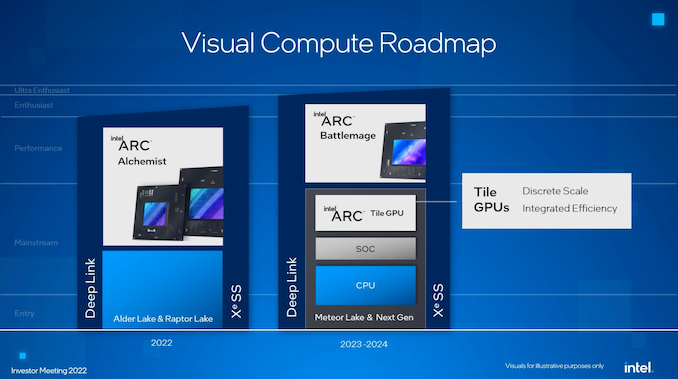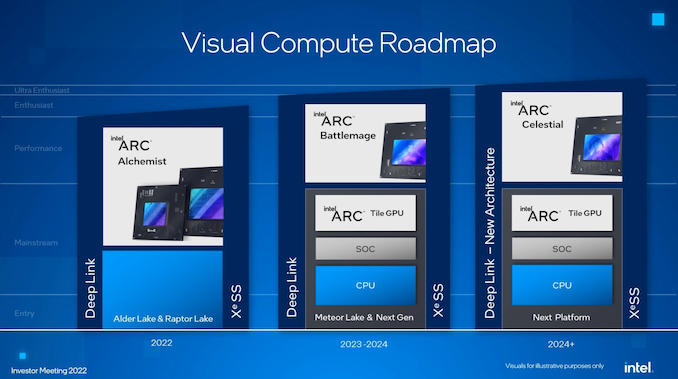Intel Meteor Lake Client Processors to use Arc Graphics Chiplets
by Ryan Smith on February 17, 2022 12:15 PM EST
Continuing with this morning’s spate of Intel news coming from Intel’s annual Investor meeting, we also have some new information on Intel’s forthcoming Meteor Lake processors, courtesy of this morning’s graphics presentation. Intel’s 2023 client processor platform, Meteor Lake was previously confirmed by the company to use a chiplet/tile approach. Now the company is offering a bit more detail on their tile approach, confirming that Meteor Lake will use a separate graphics tile, and offering the first visual mock-up of what this tiled approach will look like.
First revealed back in March of 2021, Meteor Lake is Intel’s client platform that will follow Raptor Lake – the latter of which is Alder Lake’s successor. In other words, we’re looking at Intel’s plans for their client platform two generations down the line. Among the handful of details revealed so far about Meteor Lake, we know that it will take a tiled approach, and that the compute tile will be built on the Intel 4 process, the company’s first EUV-based process.
Now, thanks to this morning’s investor presentation, we have our first look at the graphics side of Meteor Lake. For Intel’s 2023/2024 platform, Intel isn’t just offering a compute tile separate from an IO/SoC tile, but graphics will be their own tile as well. And that graphics tile, in turn, will be based on Intel’s Arc graphics technologies – presumably the Battlemage architecture, what's looking to be the Alchemist architecture.
In describing the significance of this change to Intel’s investor audience, GPU frontman Raja Koduri underscored that the tiled approach will enable Intel to offer performance more along the lines of traditional discrete GPUs while retaining the power efficiency of traditional integrated GPUs. More pragmatically, Alchemist should also be a significant step up from Intel’s existing Xe-LP integrated GPU architecture in terms of features, offering at least the full DirectX 12 Ultimate (FL 12_2) feature set in an integrated GPU. Per this schedule, this will put Intel roughly a year and a half to two years behind arch-rival AMD in terms of integrated graphics feature sets, as AMD’s brand-new Ryzen 6000 “Rembrandt” APUs are launching today with a DX12U-capable GPU architecture.
Past that, we’re expecting that Intel may have a bit more information on Meteor Lake this afternoon, as the company will deliver its client (Core) and server (Xeon) updates to investors as part of their live session later today. Of particular interest will be whether Intel embraces the tiled approach for the entire Meteor Lake family, or if they’ll hit a crossover point where they’ll want to produce a more traditional monolithic chip for the lower-end portion of the product stack. The Foveros technology being used to package Meteor Lake is cutting-edge technology, and cutting-edge tech often has cost drawbacks.
Source: Intel











20 Comments
View All Comments
dwillmore - Sunday, February 20, 2022 - link
At least you understand how poorly you write.kwohlt - Thursday, February 17, 2022 - link
By going tiles, the iGPU in Meteorlake can (and almost certainly will) be built on TSMC 3nm, while the cores (compute tile) and the rest of the CPU can use Intel 4. This disaggregated architecture can do what current designs can't - completely mix and match different node processes from different manufacturers.The first step to this was the awful Rocket Lake CPUs, which while awful products, were useful for internal processes. The eventual end goal is an architecture that's so disaggregated, you can mix RISC-V or ARM with x86, etc.
dwillmore - Thursday, February 17, 2022 - link
So it's like AMD's Zen products?drothgery - Thursday, February 17, 2022 - link
Same basic approach, some differences in the implementation details.Matthias B V - Friday, February 18, 2022 - link
Yes both AMD and Intel have the same final goal - Creating CPUs from tiles / chiplets as this creates a flexible and costefficient way of designung and manufacturing future SoCs. They took little different routes but the target is the same.Same applies to GPUs and also Nvidia is looking into it and expected to offer by 2024 for their GPUs. Apple is rumored to do the same... By mid of this decade it should become the "new normal" to manufacture any kind of IP tile / chiplet and combine it with other IP tiles / chiplets to create a SoC.
Oxford Guy - Friday, February 18, 2022 - link
Intel is refraining from using glue to put them together and will instead be applying mucilage.Matthias B V - Friday, February 18, 2022 - link
The first step wasn't RocketLake as it had none of that and was just a simple monolithic CPU with that was backportet to 14nm... Basically we see two independant big steps at Intel:- The first step was Lakefield try combining different tiles and node.
- The other step was trying big + little with AlderLake
MeteorLake now will shows their desired result combining both big changes in x86 CPU/APU design. It is basically the start of a new era!
In future we might see even more tiles such as specific ASICs, Cache, maybe even big and little cores separated... Once packaging and sheduling that is mature you can theoretically just build basic IP blocks / tiles and then create customized CPUs, APUs, GPUs according to customers needs without a new design by just combining those IP blocks / tiles and engineer the packaging around it. This could lead to fast time to market and cost savings!
Matthias B V - Friday, February 18, 2022 - link
Yeah rumors and leaks indicated for a long time that Intel uses TSMC N5 and N3 for the I/0 tile and iGPU tile while using their own 7nmESF aka Intel 4 for the CPU tile on MeteorLake... That comes to no surprise.What I am surpised is that ArrowLake already offers GAAFETs as it was expected to be on Intel 3 / TSMC N3.
IntelUser2000 - Sunday, February 20, 2022 - link
The TSMC N3 rumors didn't make sense. You need high volume manufacturing for processes to have a life, so if Intel didn't have any chips based on their own process, then they are effectively ceding the process race.So some of their mainstream lineup with high volume had to be on Intel process. And that's a very good thing for Arrowlake and Intel. Intel, because they catch up on node, the Arrowlake since it'll turn out to be a better product.
There's no 7nm ESF. There was 10nmESF renamed to Intel 7. Intel 4 was Intel 7nm.
IntelUser2000 - Sunday, February 20, 2022 - link
Early leaks indicated Meteorlake iGPU being based on DG2 Alchemist architecture.The slide is essentially showing now it'll use DG3 Battlemage architecture.